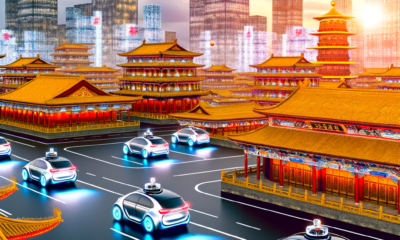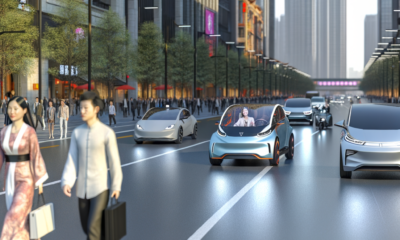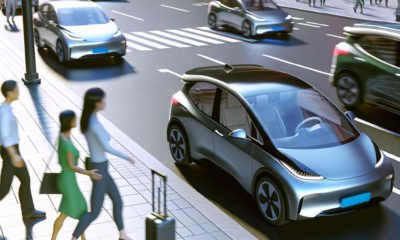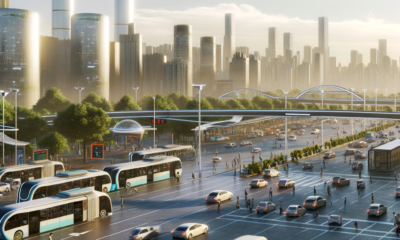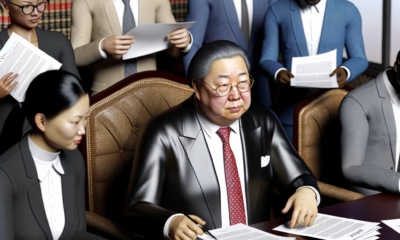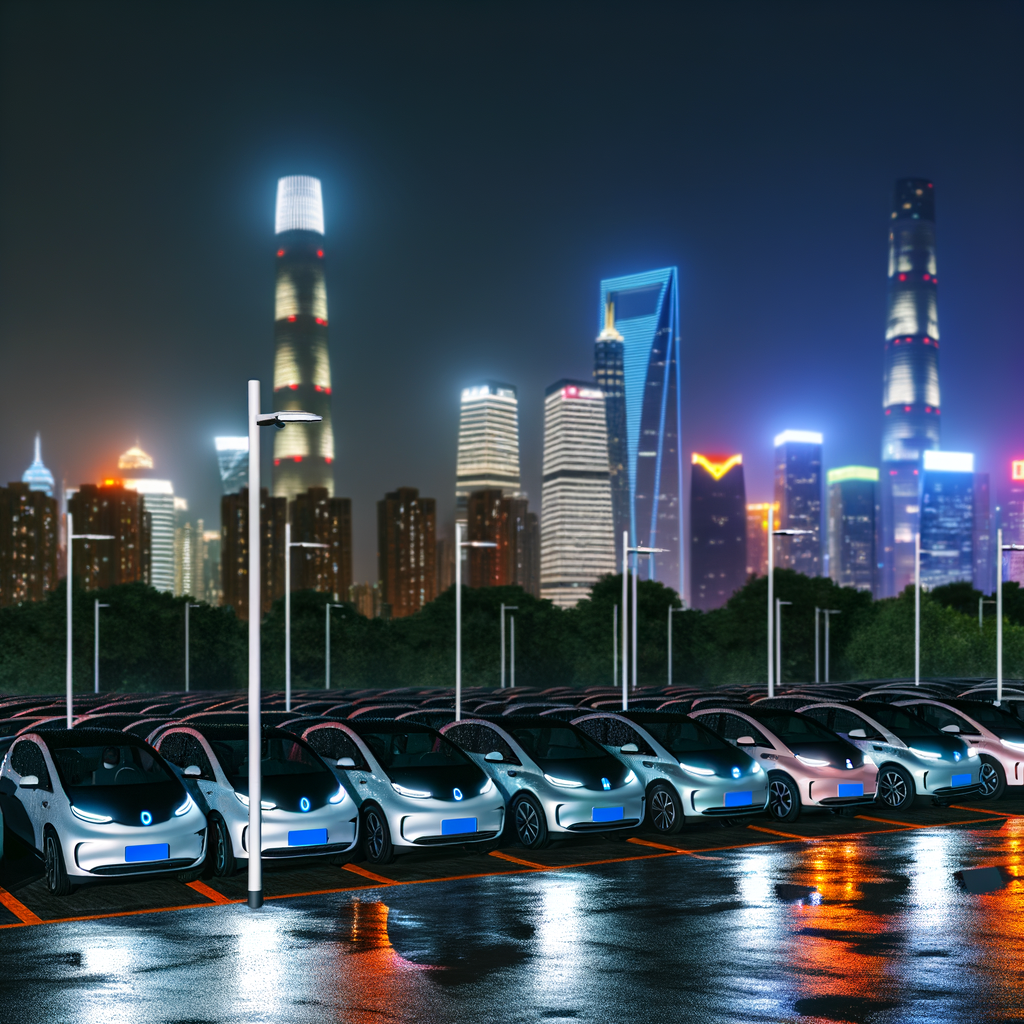
Driving the Future: Navigating Success in China’s Dynamic Automotive Landscape
In the race to dominate the world's largest automotive market, both foreign automakers and domestic car brands are tackling the challenges of China's intricate regulatory landscape and the necessity for strategic partnerships. With China at the forefront due to its growing economy, urbanization, and an expanding middle class, the demand for Electric Vehicles (EVs) and New Energy Vehicles (NEVs) is skyrocketing, driven by environmental concerns and strong government incentives. To succeed, foreign brands must engage in joint ventures with local firms to access the massive consumer base and adhere to regulations. These collaborations are crucial for understanding technological advancements and consumer preferences in a market leaning towards sustainability amid intense competition. The focus on EVs and NEVs, backed by government incentives, underscores the shift towards cleaner transportation, emphasizing the importance of navigating the regulatory framework and forming the right partnerships to flourish in China's dynamic automotive sector.
In the heart of the global automotive industry's evolution, China stands as a colossus, heralding a new era marked by rapid economic growth, a flourishing middle class, and an accelerated pace of urbanization. As the world's largest automotive market in both production and sales, China has firmly positioned itself as a pivotal battleground for both domestic car brands and foreign automakers alike. This bustling market, driven by an insatiable demand for innovative mobility solutions, has become synonymous with the cutting-edge development of Electric Vehicles (EVs) and New Energy Vehicles (NEVs), underpinned by a combination of government incentives, environmental concerns, and consumer preferences.
Navigating the complex regulatory landscape requires strategic partnerships and an intimate understanding of the local market dynamics, making joint ventures between foreign automakers and local Chinese companies a critical strategy for success. The relentless drive toward a greener future is not just a trend but a cornerstone of China's automotive market strategy, focusing on EVs and NEVs to address environmental challenges head-on. Amidst this backdrop of transformation, the role of urbanization and China's growing economy cannot be overstated, fueling the country's dominance in global automotive sales and production.
This article delves into the intricate tapestry of China's automotive sector, exploring the delicate balance between bridging East and West through foreign automakers' joint ventures, the competitive landscape shaped by domestic vs. foreign consumer preferences, and the relentless pursuit of innovation. Technological advancements are propelling China's automotive market forward, setting the stage for a future where government incentives and environmental concerns steer the sector towards sustainable growth. Understanding the dynamics of this market is essential for any stakeholder looking to navigate the competitive, dynamic, and highly lucrative environment of China's automotive industry.
1. **Navigating the Regulatory Landscape and Strategic Partnerships in the World’s Largest Automotive Market**
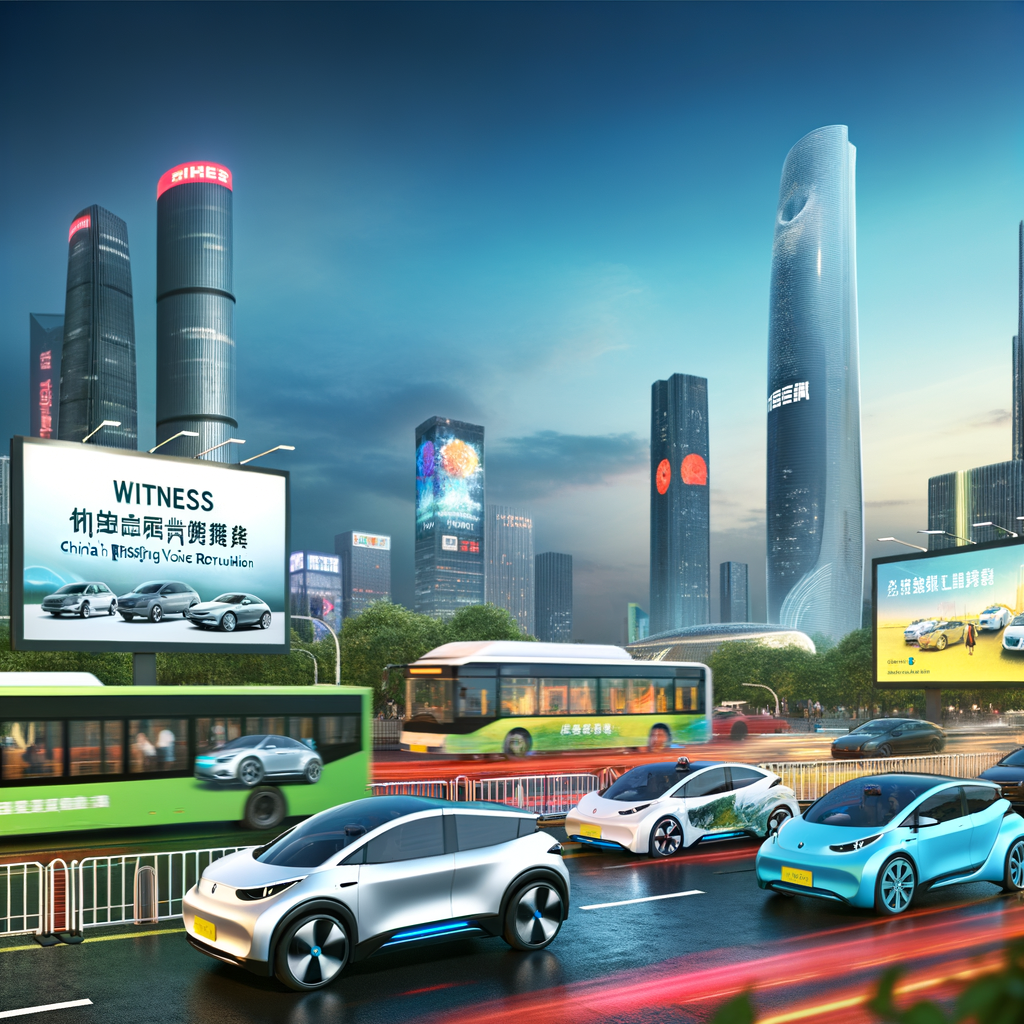
Navigating the complex regulatory landscape and forging strategic partnerships are crucial steps for success in the world's largest automotive market, China. This market, driven by its growing economy, rapid urbanization, and an expanding middle class, has positioned itself at the forefront of the global automotive industry. Both domestic car brands and foreign automakers are vying for a significant share of this lucrative market, which is characterized by a robust demand for Electric Vehicles (EVs) and New Energy Vehicles (NEVs). These preferences are not only shaped by environmental concerns but are also heavily supported by government incentives, highlighting the unique intertwining of consumer preferences and policy in China.
Foreign automakers face a particularly challenging regulatory landscape, which often necessitates forming joint ventures with local Chinese companies. These strategic partnerships are not just a regulatory formality but a vital tactic for navigating the complexities of the Chinese market. By collaborating with local firms, foreign brands can gain essential insights into consumer preferences, technological advancements, and the intricacies of market competition within China. These joint ventures enable foreign automakers to access the vast consumer base while adhering to the stringent regulations that govern the automotive sector.
The emphasis on EVs and NEVs is a clear reflection of the market's response to environmental concerns and the Chinese government's push towards cleaner, more sustainable modes of transportation. This shift is further fueled by technological advancements that are rapidly evolving within the Chinese automotive industry, making it a hotbed for innovation in electric and new energy vehicles. Government incentives play a significant role in this transition, offering subsidies and benefits to both manufacturers and consumers of EVs and NEVs, thereby accelerating the adoption of these vehicles.
Understanding and adapting to the regulatory landscape requires a deep knowledge of local laws, consumer behavior, and the ability to anticipate shifts in policy that could affect market dynamics. Furthermore, the success of any automotive brand in China depends on its ability to engage in effective strategic partnerships. These alliances are key not only to compliance but also to gaining a competitive edge in a market where competition is intense and constantly evolving.
In conclusion, the Chinese automotive market, with its emphasis on EVs, NEVs, and a rapidly growing consumer base, presents both unparalleled opportunities and significant challenges. Navigating its regulatory complexities and forging the right strategic partnerships are fundamental steps for any automaker looking to succeed in this dynamic and competitive environment. As the largest automotive market globally, China continues to shape the future of mobility, driven by its unique blend of government incentives, consumer preferences, and a commitment to technological innovation.
In conclusion, the China automotive market stands as the largest and one of the most vibrant automotive markets globally, driven by its growing economy, increasing urbanization, and a burgeoning middle class. This market's complexity is further heightened by a nuanced regulatory landscape that requires foreign automakers to enter strategic partnerships and form joint ventures with domestic car brands to successfully navigate. The shift towards Electric Vehicles (EVs) and New Energy Vehicles (NEVs), fueled by environmental concerns and robust government incentives, underscores the market’s dynamic nature and its pivot towards sustainability and innovation.
Understanding consumer preferences, staying ahead of technological advancements, and leveraging strategic partnerships are crucial for any player aiming to succeed in this competitive arena. The emphasis on EVs and NEVs not only reflects China's commitment to addressing environmental challenges but also represents a significant growth area for both domestic and foreign manufacturers. As the market continues to evolve under the influence of government policies, global economic trends, and a highly competitive landscape, the importance of agility and deep market knowledge cannot be overstated.
Navigating the China automotive market presents a lucrative opportunity for those who can adeptly manage the intricate balance between adhering to regulatory requirements, understanding consumer behavior, and capitalizing on market competition. As the world's largest automotive market continues to grow and transform, its influence on the global automotive industry will undoubtedly persist, making it an essential arena for innovation, strategic partnerships, and market leadership in the years to come.
Discover more from Automobilnews News - The first AI News Portal world wide
Subscribe to get the latest posts sent to your email.
China
Driving Innovation and Growth: Mastering the Dynamics of China’s Largest Automotive Market Amid EV Boom and Regulatory Shifts
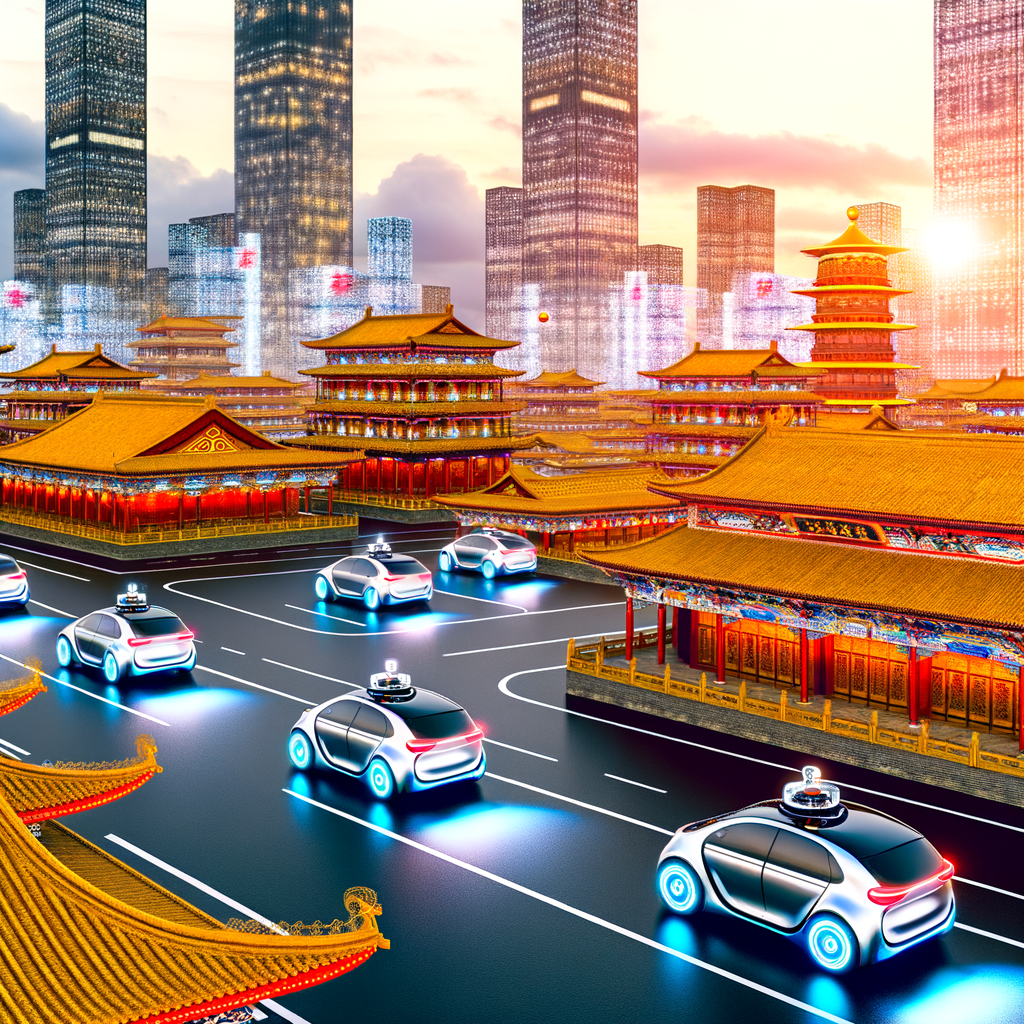
China, the world's top and largest automotive market, is driving growth and innovation in the global car industry, particularly through its focus on Electric Vehicles (EVs) and New Energy Vehicles (NEVs) amidst growing environmental concerns. With a booming economy, rapid urbanization, and an expanding middle class, both foreign automakers and domestic car brands find immense opportunities yet face challenges within the complex regulatory landscape. Strategic partnerships, such as Joint Ventures, are crucial for navigating market competition and aligning with consumer preferences that lean towards technological advancements and eco-friendly solutions. Government incentives further boost the EV and NEV market, making China a key player in the sustainable transportation revolution. Success in this competitive market requires a deep understanding of regulatory hurdles, consumer needs, and the value of collaborations to capitalize on the vast opportunities presented by the shift towards electric and smart mobility solutions.
In the realm of global automotive dominance, China stands at the forefront, not just as the Largest Automotive Market by volume but as a pivotal arena where the future of mobility is being shaped. This vast and dynamic market, fueled by a rapidly Growing Economy and accelerated Urbanization, has become the battleground for both Domestic Car Brands and Foreign Automakers, each vying for a piece of the lucrative pie. With a burgeoning middle class hungry for mobility and status symbols, and Environmental Concerns pushing the market towards greener alternatives, Electric Vehicles (EVs) and New Energy Vehicles (NEVs) are gaining unprecedented momentum. These shifts are underpinned by substantial Government Incentives and a complex Regulatory Landscape that foreign entities navigate through Strategic Partnerships and Joint Ventures with local firms.
As we delve into "Navigating the Largest Automotive Market: Trends, Challenges, and Opportunities in China's Thriving Sector," this article aims to unpack the intricacies of this competitive ecosystem. From the surge of Urbanization fueling automotive demand to the Technological Advancements and Consumer Preferences shaping the future of driving, we explore how Domestic Car Brands stack up against their foreign counterparts and the pivotal role of EVs and NEVs in the market's transformation. Moreover, the strategic maneuvering through Joint Ventures to overcome the Regulatory Landscape and the critical impact of Government Incentives in steering the market towards sustainable mobility are dissected to provide a comprehensive understanding of what it takes to succeed in China's automotive industry.
This exploration is not just about cars; it's a glimpse into how China's automotive sector mirrors the nation's broader ambitions on the world stage, reflecting a blend of market competition, innovation, and strategic foresight. The journey through China's bustling streets and sprawling urban landscapes tells a story of a nation at the crossroads of tradition and modernity, driving towards a future where it holds the keys to the global automotive kingdom.
1. **Navigating the Largest Automotive Market: Trends, Challenges, and Opportunities in China's Thriving Sector**
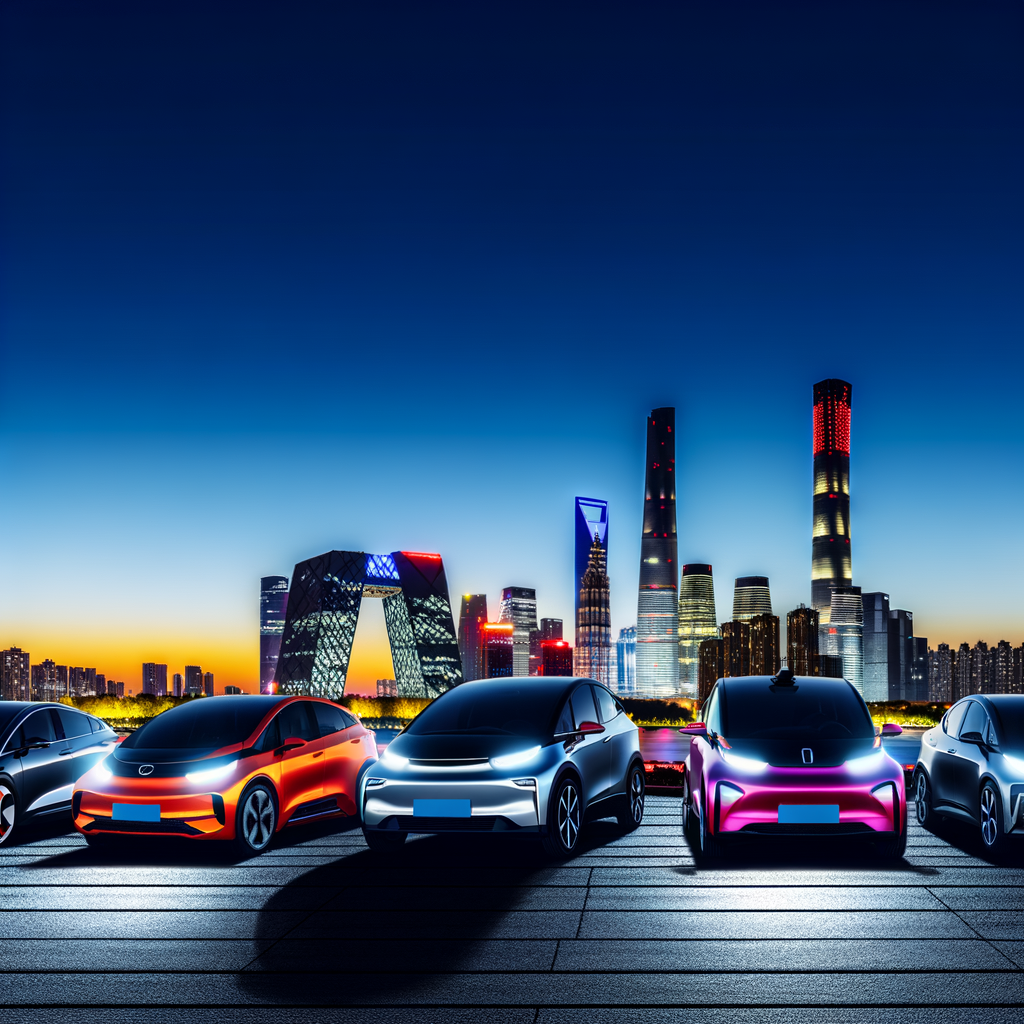
Navigating the vast and bustling landscape of the largest automotive market in the world, China stands as a beacon of growth and innovation in the global automotive sector. With its rapidly expanding economy, increasing levels of urbanization, and a burgeoning middle class, China's automotive industry presents a fertile ground for both domestic car brands and foreign automakers. The country's commitment to environmental concerns and its push for a greener future have propelled the demand for Electric Vehicles (EVs) and New Energy Vehicles (NEVs), making China a pivotal market for the evolution of sustainable transportation.
The Chinese automotive market is characterized by intense market competition, driven by consumer preferences that lean heavily towards cutting-edge technological advancements and eco-friendly solutions. Government incentives have further bolstered the market for EVs and NEVs, aligning with the global shift towards reducing carbon emissions and mitigating climate change impacts. This proactive approach by the government has not only shaped consumer behavior but has also encouraged foreign automakers to invest heavily in China's automotive future.
However, the path to success in this thriving market is fraught with challenges. The regulatory landscape in China is complex and ever-evolving, making it a significant hurdle for foreign players aiming to penetrate the market. Joint Ventures have emerged as a strategic pathway for foreign automakers to navigate these regulatory challenges, allowing them to tap into the vast consumer base by partnering with local Chinese companies. These collaborations are crucial, as they provide the necessary insights and access to the domestic market, which might otherwise be unattainable due to stringent regulations and market entry barriers.
Strategic partnerships extend beyond mere market access; they are pivotal in fostering innovation and technological advancements. The synergy between domestic and foreign firms can accelerate the development and adoption of cutting-edge automotive technologies, further driving the momentum of the EV and NEV market segments. This collaborative ecosystem is essential for sustaining growth and competitiveness in the face of global economic trends and the fast-paced nature of technological progression.
Understanding China's automotive market requires a deep dive into the nuances of local consumer preferences, which are increasingly tilting towards digital and smart mobility solutions. The digitalization of automotive services and the integration of advanced technologies such as AI and IoT are reshaping the way consumers interact with automotive brands, thereby influencing market dynamics and future trends.
In conclusion, the opportunities within China's automotive sector are vast and varied, ranging from electric and new energy vehicles to smart mobility solutions. Success in this market, however, demands a strategic approach that encompasses a comprehensive understanding of the regulatory landscape, consumer preferences, and the importance of forming joint ventures and strategic partnerships. As the largest automotive market in the world continues to grow and evolve, so too does the blueprint for succeeding in this dynamic and competitive environment.
In conclusion, China's position as the top player in the global automotive landscape is unmistakably clear. The Largest Automotive Market is not only a testament to the country's growing economy and rapid urbanization but also a reflection of its dynamic market competition and the evolving consumer preferences that favor both Domestic Car Brands and Foreign Automakers. The surge in demand for Electric Vehicles (EVs) and New Energy Vehicles (NEVs), driven by environmental concerns and robust Government Incentives, highlights China's commitment to sustainable development and its pivotal role in shaping the future of mobility.
The success of foreign automakers in this competitive market is often achieved through strategic Joint Ventures with local Chinese companies, navigating the complex Regulatory Landscape while tapping into the vast consumer base. This collaboration underscores the importance of understanding local market trends, technological advancements, and establishing strong Strategic Partnerships.
As China continues to lead the way in the automotive industry, it is clear that the market's growth is not without its challenges. However, the opportunities that lie within the Largest Automotive Market are immense, particularly for those who are adept at aligning with the government's vision, innovating in line with Consumer Preferences, and contributing to the country's environmental goals. The trajectory of China's automotive sector suggests a future that is not only promising for Domestic Car Brands and Foreign Automakers alike but also for the global automotive industry at large, as it moves towards a more sustainable, technologically advanced, and consumer-driven future.
Discover more from Automobilnews News - The first AI News Portal world wide
Subscribe to get the latest posts sent to your email.
China
Taiwan Reels from 6.4 Magnitude Earthquake: Devastation and Disruption in Chiayi and Tainan

Taiwan prepares for additional aftershocks following a terrifying magnitude 6.4 earthquake
Significant damage reported in Tainan and Chiayi, the locations closest to the earthquake's epicenter
Early Tuesday just after midnight, a severe 6.4 magnitude earthquake hit Chiayi County in southwestern Taiwan, resulting in injuries to at least 27 individuals. The quake's force was comparable to that of two atomic bombs.
According to the Central Weather Administration (CWA), the earthquake struck at 12:17 AM local time, with its epicenter located in a sparsely populated, mountainous region 37.9 kilometers (23.5 miles) southeast of the Chiayi County Hall. The tremor occurred at a depth of 9.7 kilometers (6.03 miles).
Kuo Kai-wen, who previously led the seismology center at the CWA, assessed that the earthquake unleashed energy comparable to that of two nuclear bombs.
The earthquake shook the nearby cities of Tainan and Kaohsiung in the southern region, with its tremors reaching as far as Taipei, causing skyscrapers to sway.
According to the Taiwanese fire department, there have been no fatalities, but many homes and buildings in Chiayi and Tainan sustained damage, with several partially collapsing. The agency also reported that at least 27 individuals in these areas sustained minor injuries.
In Dapu township of Chiayi, which is nearest to the epicenter, the local county authorities called off work and school. The roads suffered considerable damage, hindering any form of travel, and there were interruptions to both water and power services.
Discover more from Automobilnews News - The first AI News Portal world wide
Subscribe to get the latest posts sent to your email.
China
At Davos, China’s Vice-Premier Ding Highlights Economic Strategies and AI Dilemmas: A Dual-edged Sword in Global Tech Leadership
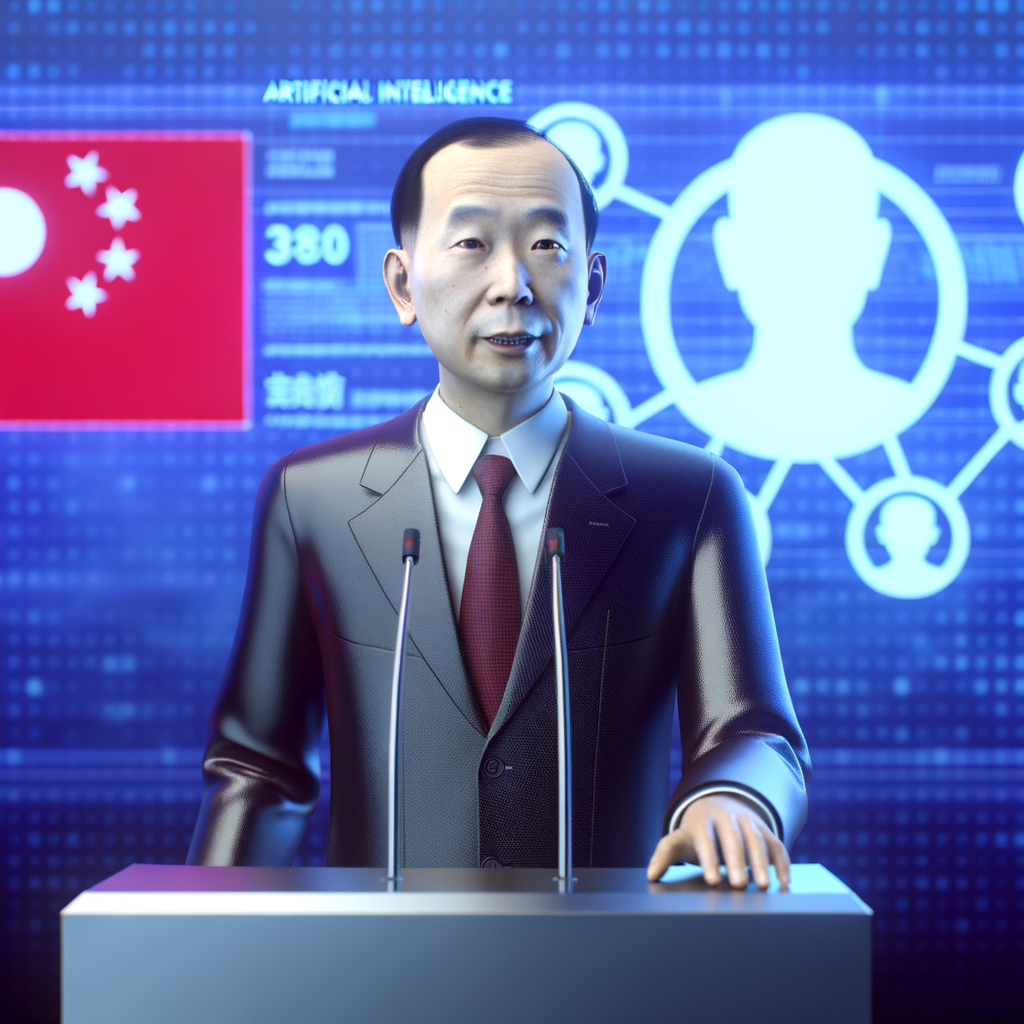
Ding cautions Davos that AI could be like 'Ali Baba's cave' or a Pandora's box – live updates
China's Vice Premier discussed the nation's economic health, international collaboration, and AI worries at the World Economic Forum in Switzerland.
China, which recorded a 5 percent increase in its economy last year, has committed to generating additional employment opportunities, reinvigorating both domestic and international investments, and leading the charge in technological independence to bolster its economy and mitigate external risks. The extent of this year's economic stimulus is yet to be determined.
Further insights from our reporting:
Coverage provided by Victoria Bela, Meredith Chen, Enoch Wong, and Wendy Wu
Discover more from Automobilnews News - The first AI News Portal world wide
Subscribe to get the latest posts sent to your email.
China
Robots Lace Up: Beijing to Host Groundbreaking Human-Robot Marathon Showcasing Technological Prowess

China Set to Hold the First-Ever Human-Robot Marathon, Aiming to Advance Robotics as a National Priority
Numerous humanoid robots are anticipated to participate in an April half-marathon in Beijing, marking their debut in such a complete event.
Will humans and robots compete in a complete race? This event is set to take place in Beijing this coming spring.
Approximately 12,000 participants are set to compete in the upcoming marathon, where they will be joined by robots provided by over 20 firms along the 21-kilometer (approximately 13-mile) course, as reported by the administrative authority of the Beijing Economic-Technological Development Area, also known as E-Town.
Awards will be given to the first three finishers.
E-Town serves as a state-level industrial zone located in the Daxing district, encompassing several industrial parks focused on advanced industries including aerospace production and semiconductor manufacturing.
Discover more from Automobilnews News - The first AI News Portal world wide
Subscribe to get the latest posts sent to your email.
China
Swift Justice: China Executes Two Following Horrific Week of Mass Killings

China Carries Out Executions Following Consecutive Deadly Attacks
Fan Weiqiu, aged 62, and Xu Jiajin, aged 21, were executed after being found guilty of conducting lethal assaults in public spaces, which authorities linked to personal issues.
According to the state news agency Xinhua, China has carried out the executions of two men who were sentenced to death for their involvement in separate lethal assaults that occurred within the same week in November.
The assault resulted in 35 fatalities and left 43 individuals wounded, in a violent public incident that deeply disturbed the country.
In the situation involving Fan, the judicial authorities in Zhuhai determined that his behaviors were motivated by the collapse of his marriage and his discontent with his life, especially in relation to the property settlement following his divorce. He was convicted of "endangering public safety by dangerous means."
Time indicated:
Survivor Recalls Noise ‘Similar to an Earthquake’ Before Fatal Car Incident in Zhuhai
The court pointed out his reprehensible intentions, the atrocious character of the offense, the cruel methods used, and the grave outcomes and substantial societal damage that resulted from his actions.
Discover more from Automobilnews News - The first AI News Portal world wide
Subscribe to get the latest posts sent to your email.
China
China’s Healthcare Crisis: Investigation Launched into Substandard Drugs Amid Outcry from Shanghai Doctors

China's health regulatory body to probe the newly released medications roster following concerns over their quality
The healthcare oversight agency is dispatching a delegation to Shanghai following claims by policy consultants that physicians, feeling powerless, are being compelled to recommend inferior medications.
"The administration stated that a key condition for including these medications in health insurance coverage is their proven quality," the agency announced, adding that it would pay attention to feedback from medical professionals regarding the drugs' performance and look into the selection process during centralized purchasing.
The response came after a proposal from 20 members of the Shanghai branch of the Chinese People’s Political Consultative Conference, China’s premier political advisory group.
According to a recent report by Caixin magazine, a group of policy advisors, primarily healthcare professionals, have observed inconsistencies in the effectiveness of certain medications acquired via mass buying. These inconsistencies are particularly noticeable in drugs used for treating high blood pressure, diabetes, and in anesthetics.
"Even raising the dosage sometimes proves ineffective," the proposal noted, as echoed by various other Chinese news outlets. "Physicians are left feeling powerless as they lack the authority to prescribe alternative medications and have no means to communicate with higher officials."
Discover more from Automobilnews News - The first AI News Portal world wide
Subscribe to get the latest posts sent to your email.
China
Digital Caution: China’s RedNote Community Advises Against Sharing Street Views with U.S. TikTok Users Amid Security Concerns
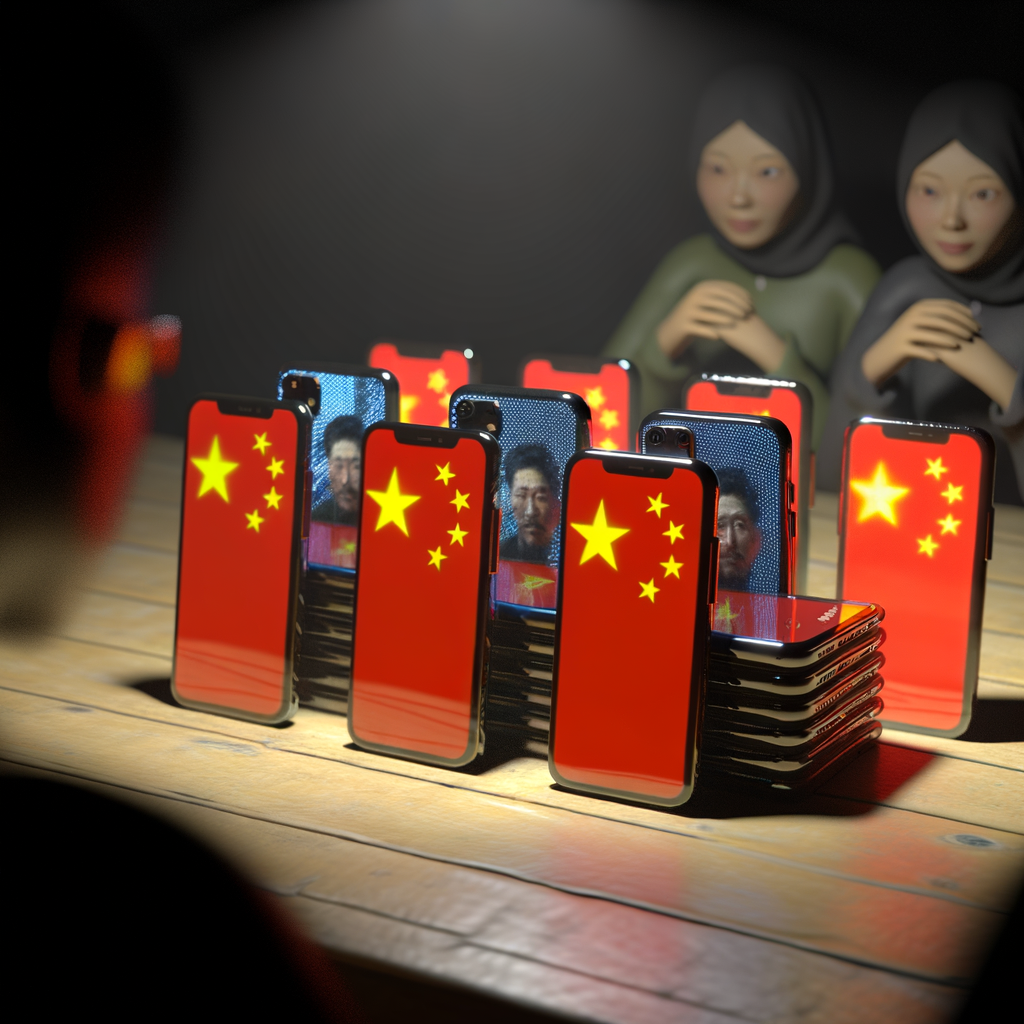
Chinese RedNote users caution each other against sharing street images with US TikTok users
They advise ignoring American requests for pictures of sensitive locations due to national security concerns
Messages began appearing on social media last week advising Chinese users to be cautious about posting images of street scenes, with cautionary notes stating, "Doesn’t it seem odd that there's such a high demand for pictures of Chinese scenery? Isn’t that peculiar? Be vigilant."
Several users advised, "Exercise caution while posting actual images of your local areas."
Google Street View offers panoramic views from various points on numerous streets globally. However, around 2010, this service, like many others from Google, was prohibited in China due to the country's strict internet censorship rules. Consequently, the majority of street view photos from China are unavailable online.
Discover more from Automobilnews News - The first AI News Portal world wide
Subscribe to get the latest posts sent to your email.
China
Mystery Deepens at AVIC: Top Executives Vanish from Website Amid Absence from Public Eye

Chinese aerospace company AVIC has taken down the online profiles of its leading executives. General Manager Hao Zhaoping and Yang Wei, the principal designer of the J-20 stealth fighter, have been absent from the public eye for several months.
Caixin initially covered the deletion of the two profiles, noting that the updates occurred on Saturday. Subsequently, that report was removed.
Yang's biography on the Chinese Academy of Sciences' website, where he served in the science and technology section, has been removed.
Over the past few months, Yang and Hao have been noticeably absent from the leadership meetings at AVIC, a crucial entity in Beijing's efforts towards military modernization and technological independence.
Discover more from Automobilnews News - The first AI News Portal world wide
Subscribe to get the latest posts sent to your email.
China
Strategic Shifts: U.S. to Train Taiwanese Navy Amid Budget Reevaluations

The U.S. has entered into an agreement to provide training for Taiwan's naval forces while the island considers reducing its budget for military exchanges. In an unusual revelation, Taiwan's defense ministry announced that American experts will travel to Taiwan for a specialized two-year training program.
In an announcement on Taiwan's official government procurement website, the ministry revealed that the United States has consented to dispatch staff to Taiwan for a dedicated two-year maritime training initiative.
The training sessions are set to take place at the main facilities of Taiwan’s navy and marine corps, which are situated in the Zuoying district, close to Kaohsiung in the south.
The announcement did not detail the positions held by the US personnel participating in the training or the precise type of training being conducted. Nonetheless, it mentioned that the training was anticipated to conclude by the end of 2026.
Discover more from Automobilnews News - The first AI News Portal world wide
Subscribe to get the latest posts sent to your email.
China
Crackdown on Corruption Spurs Employment: China Sees Surge in Disciplinary Jobs Amidst Tight Market

China's Campaign Against Corruption Spurs Job Creation
Nationwide, disciplinary bodies are actively hiring, presenting new job opportunities in a challenging labor market
Seeking: College-educated individuals aged 20 to 35, free from criminal history, with a minimum stature of 170 cm (5.57 ft) for males and 158 cm for females. Preference given to former military personnel or those with police academy training.
Online platforms are increasingly displaying advertisements, placed by recruiters throughout China, seeking individuals for a highly confidential position.
The task assigned to the candidate, should they agree to undertake it, involves monitoring discredited authorities at holding facilities managed by the disciplinary sectors of the Communist Party.
An investigation into employment websites and Chinese social platforms showed that security departments and regulatory authorities in at least 15 provinces were recruiting for "caretaker" roles at detention facilities last year, with some regions looking to hire for hundreds of open positions.
Time Displayed:
What are the issues with professional soccer in China?
Discover more from Automobilnews News - The first AI News Portal world wide
Subscribe to get the latest posts sent to your email.
China
China Sharpens Science and Tech Leadership Amid US Tensions: Vice-Premier Ding Xuexiang Chairs Key Policy Meeting

Key Figures Behind China's Tech Ambitions Unveiled Amid Growing US Competition
A strategic session chaired by Vice-Premier Ding Xuexiang disclosed the key players in China's technology sector, with experts highlighting an emphasis on integrating military and civilian technological efforts.
A significant policy conference has highlighted the main governmental figures steering China's advancements in science and technology, as the nation strives for greater coordinated control in these critical areas.
The roster features representatives from the finance and education departments, leaders in academia, heads of regional governments, and military officials, as revealed in footage from the national science and technology conference broadcasted by the state-run CCTV.
Ding's attendance elevated the event's prominence, which in previous years had typically been led by the minister of science, the most recent being in December 2022.
The deputy prime minister serves on the Politburo Standing Committee, the central nucleus of the party's authority. Monday's session marked Ding's inaugural occasion presiding over a policy meeting focused on science, in his role as the head of the commission.
It was not known that Ding was the leader until June, during which he spoke to prominent scientists at a conference in Beijing.
Discover more from Automobilnews News - The first AI News Portal world wide
Subscribe to get the latest posts sent to your email.
China
Cross-Strait Thaw? Mainland Chinese Academics’ Taiwan Visit Sparks Debate on Future Relations

Is the travel of mainland Chinese scholars to Taiwan a sign of warming relations across the strait?
The visit could pave the path for increased informal 'Red-Green' interactions, though experts caution that formal negotiations appear improbable currently.
Yet, certain experts maintain a skeptical view, proposing that the governing Democratic Progressive Party (DPP) in Taipei might be attempting to give the false impression that official negotiations with Beijing could occur.
Yan Anlin, who heads the academic committee at the Shanghai Institutes for International Studies, along with Sheng Jiuyuan, the director of the Centre for Taiwan Studies at Shanghai Jiao Tong University, received permission from Taiwanese officials to travel to the island from January 5 to January 10.
Taiwan's Mainland Affairs Council, responsible for managing relations with China, acknowledged their visit on January 9. This confirmation followed reports by local news outlets that the duo had engaged with members from two Taiwanese research institutes, with one reportedly having ties to the DPP.
"Council spokesperson Liang Wen-chieh confirmed their presence in Taiwan, stating, 'We believe that interactions between think tanks from both sides are advantageous for enhancing mutual understanding.'"
Time Check:
Chinese President Xi Jinping tours an island near Taiwan following PLA military exercises
He also mentioned that the council would "organize appropriate settings for discussions on specific matters," though he refrained from sharing the particulars of their conversations.
Discover more from Automobilnews News - The first AI News Portal world wide
Subscribe to get the latest posts sent to your email.
-

 AI3 months ago
AI3 months agoNews Giants Wage Legal Battle Against AI Startup Perplexity for ‘Hallucinating’ Fake News Content
-

 Tech2 months ago
Tech2 months agoRevolutionizing the Road: Top Automotive Technology Innovations Fueling Electric Mobility and Autonomous Driving
-

 Tech2 months ago
Tech2 months agoRevving Up the Future: How Top Automotive Technology Innovations Are Paving the Way for Sustainability and Safety on the Road
-

 Tech2 months ago
Tech2 months agoDriving into the Future: Top Automotive Technology Innovations Transforming Vehicles and Road Safety
-

 Tech1 month ago
Tech1 month agoRevving Up Innovation: How Top Automotive Technology is Driving Us Towards a Sustainable and Connected Future
-

 Tech3 months ago
Tech3 months agoRevving Up Innovation: Exploring Top Automotive Technology Trends in Electric Mobility and Autonomous Driving
-

 Tech3 months ago
Tech3 months agoRevving Up Innovation: How Top Automotive Technology is Shaping an Electrified, Autonomous, and Connected Future on the Road
-
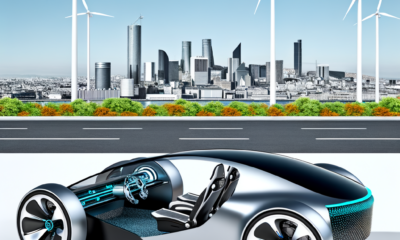
 Tech3 months ago
Tech3 months agoDriving into the Future: The Top Automotive Technology Innovations Fueling Electric Mobility and Autonomous Revolution




